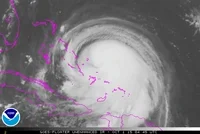Hurricanes
are slowing down, and that's bad news
University of Wisconsin-Madison
 Some hurricanes are moving more
slowly, spending increased time over land and leading to catastrophic local
rainfall and flooding, according to a new study published Wednesday (June 6) in
the journal Nature.
Some hurricanes are moving more
slowly, spending increased time over land and leading to catastrophic local
rainfall and flooding, according to a new study published Wednesday (June 6) in
the journal Nature.
While hurricanes batter coastal
regions with destructive wind speeds, study author James Kossin says the speed
at which hurricanes track along their paths -- their translational speed -- can
also play a role in the damage and devastation they cause. Their movement
influences how much rain falls in a given area.
This is especially true as global
temperatures increase.
"Just a 10 percent slowdown in hurricane translational speed can double the increase in rainfall totals caused by 1 degree Celsius of global warming," says Kossin, a researcher at the National Oceanic and Atmospheric Administration's (NOAA) Center for Weather and Climate. He is based at the University of Wisconsin-Madison.
The study compared 68 years
(1949-2016) of worldwide hurricane track and intensity data, known as
best-track data, from NOAA to identify changes in translational speeds. It
found that, worldwide, hurricane translational speeds have averaged a 10
percent slowdown in that time.
One recent storm highlights the
potential consequences of this slowing trend. In 2017, Hurricane Harvey stalled
over eastern Texas rather than dissipating over land, as hurricanes tend to do.
It drenched Houston and nearby areas with as much as 50 inches of rain over
several days, shattering historic records and leaving some areas under several
feet of water.
How much hurricanes have slowed
depends on where they occur, Kossin found. "There is regional variation in
the slowdown rates when looking at the 10 percent global average across the
same time frame," he says.
The most significant slowdown, 20
percent, occurred in the Western North Pacific Region, an area that includes
Southeast Asia. Nearby, in the Australian Region, Kossin identified a reduction
of 15 percent. In the North Atlantic Region, which includes the U.S., Kossin
found a 6 percent slowdown in the speeds at which hurricanes move.
When further isolating the analysis
to hurricane speeds over land, where their impact is greatest, Kossin found
that slowdown rates can be even greater. Hurricanes over land in the North
Atlantic have slowed by as much as 20 percent, and those in the Western North
Pacific as much as 30 percent.
Kossin attributes this, in part, to
the effects of climate change, amplified by human activity.
Hurricanes move from place to place based on the strength of environmental steering winds that push them along. But as the Earth's atmosphere warms, these winds may weaken, particularly in places like the tropics, where hurricanes frequently occur, leading to slower-moving storms.
Hurricanes move from place to place based on the strength of environmental steering winds that push them along. But as the Earth's atmosphere warms, these winds may weaken, particularly in places like the tropics, where hurricanes frequently occur, leading to slower-moving storms.
Additionally, a warmer atmosphere
can hold more water vapor, potentially increasing the amount of rain a
hurricane can deliver to an area.
The study complements others that
demonstrate climate change is affecting hurricane behavior.
For instance, in 2014, Kossin showed that hurricanes are reaching their maximum intensities further from the tropics, shifting toward the poles in both the Northern and Southern Hemispheres.
These shifts can deliver hurricanes to areas -- including some heavily populated coastal regions -- that have not historically dealt with direct hits from storms and the devastating losses of life and property that can result.
Another study, published in April by
researchers at the National Center for Atmospheric Research, used a modeling
approach to look at what would happen to hurricanes under future climate
projections.
Using real hurricane data from 2000-2013, the researchers found future hurricanes will experience a 9 percent slowdown, higher wind speeds, and produce 24 percent more rainfall.
Using real hurricane data from 2000-2013, the researchers found future hurricanes will experience a 9 percent slowdown, higher wind speeds, and produce 24 percent more rainfall.
"The rainfalls associated with
the 'stall' of 2017's Hurricane Harvey in the Houston, Texas, area provided a
dramatic example of the relationship between regional rainfall amounts and
hurricane translation speeds," says Kossin.
"In addition to other factors affecting hurricanes, like intensification and poleward migration, these slowdowns are likely to make future storms more dangerous and costly."
"In addition to other factors affecting hurricanes, like intensification and poleward migration, these slowdowns are likely to make future storms more dangerous and costly."